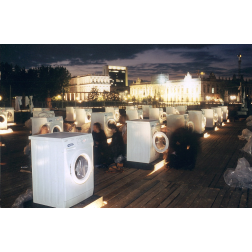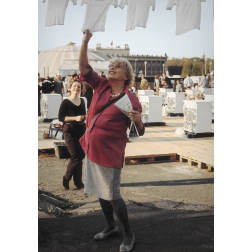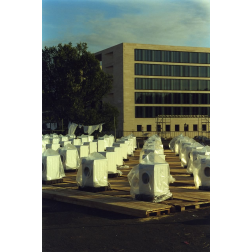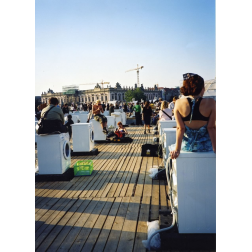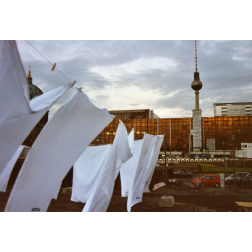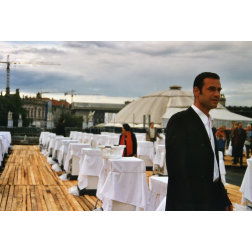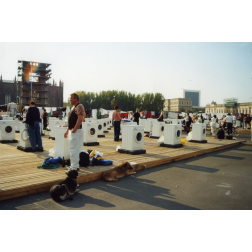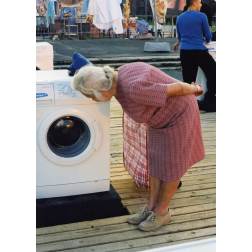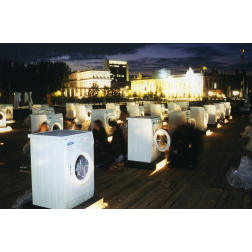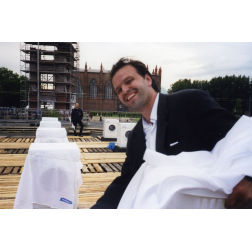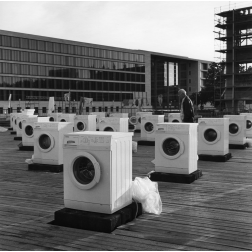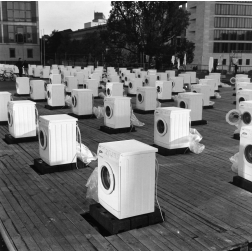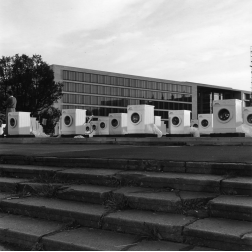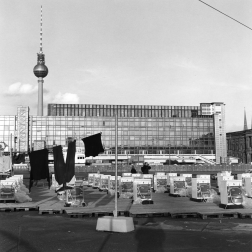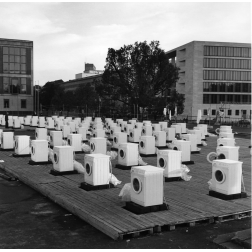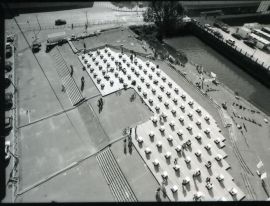weiss104 (white104)
a temporary national monument
Filomeno Fusco und Victor Kegli, 2000
Art in public space
Schloßfreiheit / Schloßplatz, Berlin
In our cultural awareness, the term “national monument” raises various associations and images. Artistically, it led to a number of confusing mythological forms, heroic images of rulers, and allegories turned into stone.
What most of these oversized monuments have in common is, primarily, this: they express distance rather than closeness to the events they are originally supposed to convey. They remain eternal signs of a past cultural and political identity, bear witness to national-monarchistic ambitions, religious strife, fanatic despotism, and revolutionary upheavals. So there is a lot of meaning behind such works – and yet these relics, steeped in history, often seem to be bulky objects within the cityscape, not really fitting in with contemporary national self-conceptions.
The “temporary national monument” weiss 104, which was realised on Berlin’s Schlossplatz (Palace Square) in the autumn of 2000, has shown that a monument of this kind need not merely be a sign for a certain cultural notion. It should also be a place for communication and the active examination of history. Filomeno Fusco and Victor Kégli installed 104 washing machines along the central square. From September 2nd (the former and first German memorial day of Sedantag), the people of Berlin had the opportunity to wash their dirty laundry for free in this open-air laundrette. In the immediate vicinity of the chancellery a platform was created that, as well as allowing visitors to clean their usual piles of laundry, also served as a stage for engaging with local history.
The artists did not randomly choose the Schlossplatz as the site of their work. The square is historically saturated and was used as a place for representing national identity for over one hundred years. In hindsight, we can see that this identity always had to redefine itself and was hence always temporary – just like the washing machine field, which only lasted for 32 days. This can also be explained by the changing use of the square.
The area lies directly next to the river Spree, and in the middle of the 19th century, it was still part of a public swimming bath. In 1897, it acquired an official character when an impressive statue of emperor Wilhelm I was unveiled here in memory of the German Empire’s foundation. Later, the national socialists declared the monument to be a “shrine of the Reich” and celebrated it with marches on the square. The government of the GDR was not impressed with the statue and had it ground down. The party planned to erect an anti-fascist monument in its stead. However, this plan was realised elsewhere. What remained was an empty space in the centre of Berlin’s government quarter.
Fusco and Kégli were the first to use this “vacancy of memory” to revive the discussion about the function and necessity of the square as an open space for communication – 104 years after the unveiling of the Wilhelm I monument. And they did this at a time when the German identity was again severely shaken. There was the unsavoury GDR past that people wanted to forget about as quickly as possible, and not only in terms of ideology, but also representation. The consequence was that many of the whopping buildings that stemmed from the former East-German reality were detonated out of the cityscape. Also, the “party of the German unity”, the CDU, had caused a major political disruption with the scandal about its illicit bank accounts. The fiasco within the party found its climax in the media coverage at the turn of the millennium and damaged the conservative party fundamentally.
So it is no surprise that weiss 104 was met with many associations at that time. “A monument against the white-washing of history”, “the conference of white-washers”, or a “new spin on German art” are only three of the various comments and titles which the international press used for the unusual art project.
The immense media interest also increased the amount of discussions on the Schlossplatz. The act of washing provided the necessary framework for a dialogue: the visitor was forced to stay on the square, at least during the washing programme. Afterwards, one could, for a while, dry the wet textiles on a line along the former arcades of the Wilhelmine monument. The waiting time was used to write into the guest book of the corresponding washing machine and to talk to the other visitors about one’s experiences, i.e. historical facts, everyday banalities, or political discourses that were also due to the special topography of the site. The weiss 104 installation also served as an inspiration for spontaneous artistic events – concerts and readings, for example – and political actions, e.g. the citizen’s initiative against the dismantling of the Palace of the Republic.
In this sense, weiss 104 tied in with the tradition of the washhouse and its tradition of passing things on orally. “The traditional washhouse was a space for free speech and gossip. At the same time, it always used to be a meeting point for democratically voicing your opinion and also forming your opinion”, the artists explain. “We wanted to create a space that supports direct action and not passive observation.” The work, then, was an invitation to participate that did more for the active discourse about history than many marble monuments.
On October 3, the German Unity Day, the installation was finished. More than 5000 visitors from different social, cultural, and political backgrounds were able to use the open washhouse. The washing machines and their “CVs” – the guest books – were publicly auctioned. The square returned to its undefined meaning. Media interest in the installation, which now dates back over one decade, has remained to this day, however.
Katrin Diederichs
After weiss 104, the Berlin Schlossplatz was the ground for further temporary projects, like the Temporäre Kunsthalle [Temporary Art Gallery](2008-2010). In April 2011, the minister for culture, Bernd Neumann, presented the final design for a Unity memorial that will be erected on the base of the ground-down Wilhelm I monument. It will be a giant, walkable bowl named Bürger in Bewegung (Citizens in Movement).
